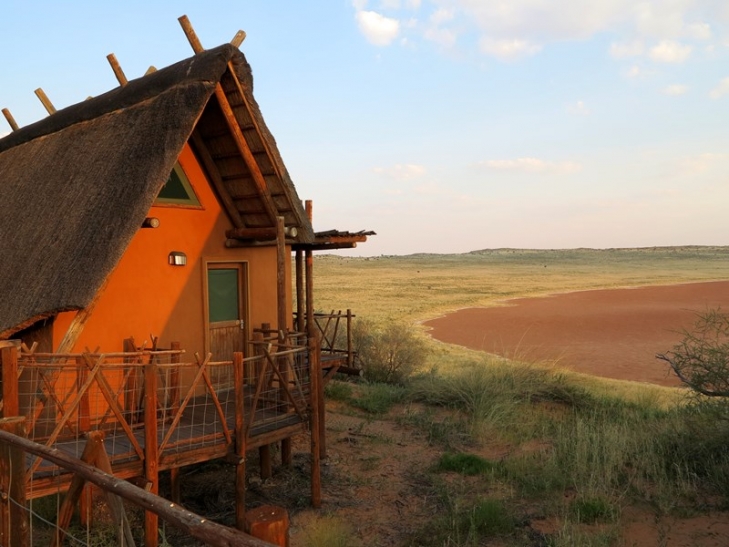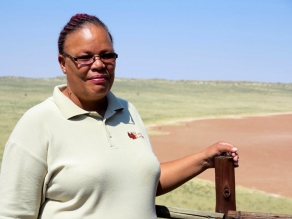Connecting People to Nature: World Environment Day – 5 June
Descendents of the original inhabitants of southern Africa, the Khomani San of the Kalahari are revered for their intimate knowledge of bush lore. These skills are now being transformed into sustainable livelihoods for this community, on the vast tracts of land they own in and around Kgalagadi Transfrontier Park in the Northern Cape. If you go there, you’ll meet them in person.
‘Do you see the heart?’ asks guide Koos Visser, as we stand at !Xaus Lodge overlooking the dry red pan below. ‘Look at the indentation on the right side of the pan and you will see it easily,’ he says, tracing the heart outline with his finger. !Xaus means ‘heart’ in Nama, and the pan marks the very place where the vast tracts of land owned by the Khomani San and Mier communities meet. Not just their land, but their hearts meet here too, in this pan.
Landmark community conservation
The 50 000 ha owned by the two communities (25 000 ha each) is in the south-western section of iconic Kgalagadi Transfrontier Park; it’s known as !Ae!Hai Kalahari Heritage Park and is managed contractually for the two communities by SANParks. This is a visionary community conservation model, and so was the proclamation of Kgalagadi Transfrontier Park in 2000. It’s the first transfrontier park in Africa; 3.6 million hectares that join together the Kalahari Gemsbok National Park in South Africa and Botswana’s Gemsbok National Park into a vast, single conservation area.
!Xaus Lodge success story

Koos Visser shows the spiky gemsbok melons and a broom bush on the right.As we head out into the red dunes in the Land Cruiser, the early morning sun setting the sand on fire with a crimson glow, Koos is clearly in his element. He’s animated when we stop and hop out of the vehicle. ‘Everything we need is right here,’ he smiles. ‘There’s a broom bush ready for sweeping, and it makes a lovely gift for Bushmen ladies. Look at that spiky gemsbok melon lying in the sand; you can brush your hair with the spikes and, when you are groomed, inside is a full meal of food and water. Over there are dune reeds for house building and this gnarled root of the Shepherd bush tastes a bit like coffee – if you grind it and have an imagination. All you need for living is right here in this tiny patch of sand,’ he says. If you know where to look, the Kalahari is a complete outdoor supermarket.

We take a slow drive back to the !Xaus Lodge, and it’s quick when compared to traversing the 90 red sand dunes to get there from the collection point. Koos talks lyrically about life in the desert, his home space. ‘Out here it’s open, there are lots of stars and it’s quiet, with just the sound of birds and animals calling at night. There’s no signal for cell phones or DSTV, nature is your entertainment.’ He says that’s exactly what people love most about coming to !Xaus Lodge, because you definitely can’t arrive there by accident.

Back at the lodge again, we head down to the open-air craft workshop close by. It’s a simple reed boma and we find loin-cloth clad Khomani San men and women inside, carefully fashioning beads from ostrich egg shell, polishing bone for pendants, and drilling holes in wild seeds that will reincarnate as beads. Children play in between and a fire smokes in one corner. They all chat in clicks as they go about their crafts, which will be bought by fascinated tourists and taken home with pride. The Bushmen are visionary when it comes to creating something out of apparently nothing. Even dried gemsbok testicle pouches are for sale here.
Annatjie van Wyk also works at the lodge and is part of the housekeeping team. She’s from the Mier community and says: ‘The first time I saw the lodge, I fell in love. I really enjoy living amongst wildlife and seeing the sun rise and set every day. It’s so quiet and calm here and my passion is cleaning, so I am in the right place. For me it’s a privilege to work here and I will stay until I retire.’ Annatjie says there are plenty of guests who visit and just don’t want to leave. ‘They love it so much they just want to stay. I think people find peace here.’
Unique tourism offerings

Dirk Pienaar’You disconnect to reconnect, through the silence of the place,’ explains Tourism Officer for the Khomani San, Dirk Pienaar. ‘And a unique selling point of this Kgalagadi area is that tourists here can truly participate in an experience with the community too. It’s authentic and there are unusual offerings here – like a home stay in a traditional dwelling, seeing and hearing the stories of historical sites like heritage trees and the old cave jail, and tasting local food. The challenge is teaching people the business skills needed to be able to tap into this tourism potential.’
Story and photos by Keri Harvey
Click here to book at !Xaus Lodge
Peace Parks Foundation has been poudly supporting the development of the !Ae!Hai Kalahari Heritage Park, to preserve the cultural and traditional knowledge of the ‡Khomani San and Mier communities, since 2009.





